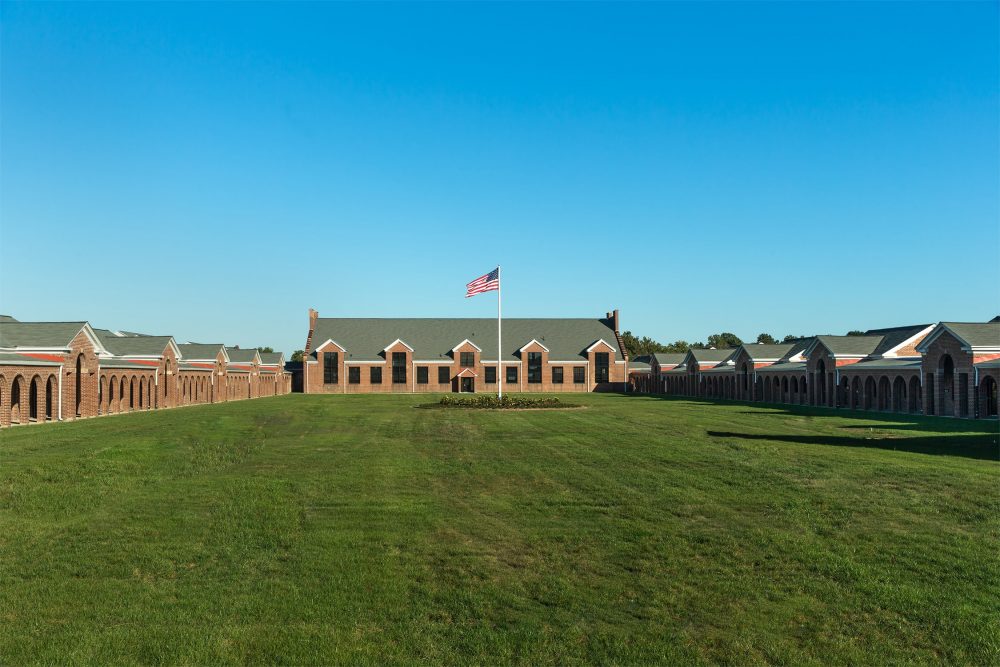Redevelopment of the final piece of the 2,300-acre property in Lorton that formerly housed prisons for the D.C. Department of Corrections has begun.
Officials broke ground last month on Liberty Crest at Laurel Hill, a project that will transform the 80-acre historic core of the correctional facility into a neighborhood of single-family homes, townhouses, apartments and businesses. Local leaders hope the project will give an economic boost to a part of Fairfax County once known mostly for the presence of the prisons.
The $188 million project is a partnership between the county and two private developers — Alexander Co. and Elm Street Development. The county will contribute up to $12.7 million for the design and construction of public infrastructure for the site.
The two-phase project includes building new houses and roads, as well as converting the reformatory buildings and other historic structures into modern spaces for residences and businesses.
“The intent is to leave the majority of the buildings intact and to adaptively reuse them,” said Chris Caperton, project manager for the county Department of Planning and Zoning. The developers have secured tax credits to help offset the costs of preserving and modernizing the structures, he said.
In the first phase of the project, scheduled for completion in 2017, 165 apartments will be created in buildings that formerly housed inmates. The power plant will be converted into commercial space, and the prison chapel will be adapted for community use, possibly as a church, Caperton said.
The first phase also includes construction of 83 townhouses and 24 single-family homes, along with improvements to roads, utilities and storm water systems on the property. Additional homes, businesses and infrastructure improvements are planned for the project’s second phase, which is to be completed in spring 2019.
The Lorton Reformatory opened in 1916 as a facility to rehabilitate serious offenders from Washington, D.C., according to county documents. The complex, built in the 1920s using bricks made on-site by inmates, consists of dormitories and administration buildings surrounding a central courtyard.
Caperton said that the correctional facility’s origin in the early 20th century “works to our advantage” in making it adaptable for modern uses.
“Light and open air was a theme of the Progressive Era, when the buildings were established,” he said.
Most of the 2,300-acre property now known as Laurel Hill has been developed since Fairfax County purchased it from the District for about $4.2 million when the prison closed in 2001. The Workhouse Arts Center opened in the old prison workhouse in 2004, and three schools, a park, a network of trails, the Laurel Hill Golf Club and Spring Hill Senior Living Community were added over the next decade.
The core prison site is the last piece of the Laurel Hill property to be developed, following a 14-year process that included more than 35 public meetings — “to make sure we were solid with the community,” Caperton said.
Rep. Gerald E. Connolly (D-Va.) said in an interview that the decision to close the prison and transfer the land to Fairfax County has transformed that area.
“When there was development down in South County, people desperately wanted an address that did not say Lorton,” Connolly said. “It was just a very negative brand. And all of that changed with the closing of the prison.”
Connolly, who was a member of the Fairfax County Board of Supervisors when the decisions were made to close the prison and transfer the property to the county, credited federal and local leaders for having the vision to preserve the land, develop parts of it for public purposes and reuse the buildings.
“And look what it did,” Connolly said. “We built a world-class golf course. We have playing fields and open space and an arts center . . . and it’s a very vibrant and active part of Northern Virginia now.
“Today, I don’t think anybody would be ashamed to say they live in or work in Lorton,” Connolly said.

